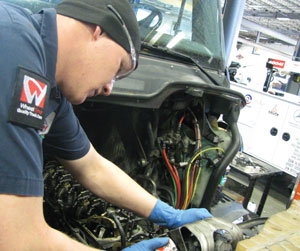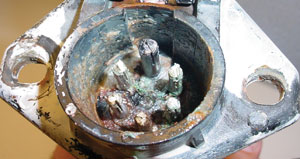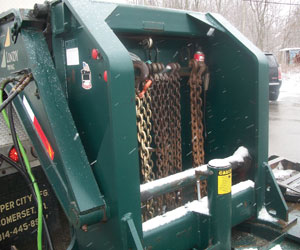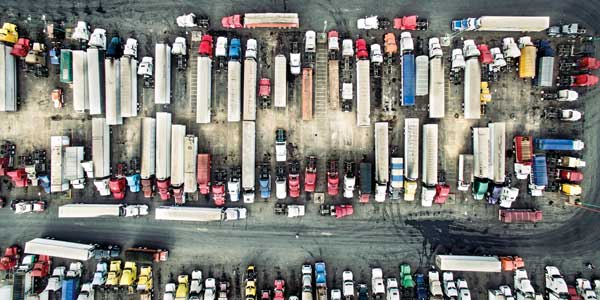According to Bill Lynch, service manager at Florida Detroit Diesel – Allison (FDDA), a member of the WheelTime Quality Truck Care Network, approximately 25% of general repairs that come through the company’s shop involve electrical systems. This high volume does not include engine work. When the engine is added to the equation, as much as 50% to 60% of the maintenance FDDA handles is related to electrical systems. The most common issues in electrical system repair are starters, alternators, batteries and wiring.
Some of this maintenance is necessary due to general wear and tear on the systems, but according to Lynch, it can be reduced by, “Simply doing a visual inspection of the truck, including the electrical systems, while completing an oil change or other preventive maintenance review. You have to watch for dirt, oil and other build-up that can cause corrosion. This type of attention to detail in maintenance can make or break a fleet.”
Choosing batteries
According to Kalyan Jana, development support manager—specialty markets for EnerSys, manufacturer of the Odyssey battery, “First and foremost, the fleet manager must decide what kind of application the battery must support. If it will be used only in a starting, lighting and ignition (SLI) application, the battery with the highest CCA and reserve capacity ratings should be chosen. Also, if extreme cold weather is an issue, the battery selected must be able to deliver the needed performance even when the temperature drops to -40ºF (or ºC). This will ensure that a vehicle is not stranded because the battery is unable to crank the engine at low temperature. If the application requires the battery to power an auxiliary power unit (APU) as well, the fleet manager must look for a true dual purpose battery that can deep cycle and deliver high engine cranking amps.”
Jana goes on to say the maintenance required will depend on the battery chosen. For example, thin plate pure lead (TPPL) absorbed glass mat (AGM) batteries require no maintenance, other than ensuring they are properly charged and they are kept clean. Because they do not have lead posts, the terminals are totally maintenance-free as long as they are installed with the proper torque. Other AGM batteries may have lead posts that require periodic retorquing. A flooded battery will also require periodic topping off with distilled water and garages will need to have spill containment systems in place.
| Enemy #1: Corrosion Phillips Industries notes that corrosion in electrical systems adds quite a bit of cost to routine maintenance for fleets. Just like when corrosion eats away at exterior surfaces on vehicles, when it enters electrical circuits, the cost is high. Phillips said it knows this and directs much of its testing and product development to finding solutions. 
One example of the consequences of corrosion on electrical systems discovered through the Phillips test method is that tractor/trailer connections are not always adequately protected. For instance, the J560 (7-way) connector is the only automotive connection that is routinely opened and exposed directly to harmful environmental conditions. When coiled cables are unplugged from the trailer side only, they remain “live” and need to be stored properly. Unfortunately, many times they are not. Even when connected, the nature of the J560 design allows for considerable waterborne contaminant attacks. The J560 circuit, which has the longest duty cycle, has a reputation for corroding first. The circuit is at particular risk in winter months when road de-icers are used. Phillips adds that its Sta-Dry cables, connectors, sockets, plugs and tubing are designed specifically to keep out any moisture, reducing corrosion build-up throughout tractor and trailer electrical systems. |
“The usual precautions when handling electricity must be taken when working with batteries. It must always be remembered that batteries can deliver high short circuit currents that can severely injure or even kill someone,” Jana states. “All tools must be insulated to prevent accidentally bridging the gap between positive and negative terminals that will generate high short circuit currents. Personal jewelry such as rings, watches, metal bracelets and necklaces must be removed before one starts working with batteries. Finally, safety goggles must be worn when working on or around batteries.”
The most important consideration is to make sure the battery is fully charged before it is placed in storage. Also, it must be in a true open circuit condition when put in storage—this means that there cannot be any load on the battery, however small, and the only way to ensure that is to physically remove the battery from the circuit. If the battery cannot be taken off the vehicle, it should be disconnected from the circuit either by using a master disconnect switch or physically removing one of the battery cables.
Jana adds, “Since purchasing batteries for a fleet involves spending a significant amount of money, the fleet manager should consider running cost of ownership calculations rather than focus only on the purchase price of the battery.”
Batteries are perishable
Bob Jeffries, national fleet technical support for Remy Inc., says that batteries are perishable devices that wear out at some point in time. With use, they deteriorate and eventually become incapable of performing their important jobs. In addition, new, good batteries may become discharged for various reasons. Neither worn out nor discharged batteries can supply the power necessary for cranking. Thus, the battery check becomes the starting point for diagnosing electrical system problems.
Because of vibration, corrosion, temperature changes or damage, the performance of wiring, connections and secondary components, as well as the function of the starter and alternator, can deteriorate. This in turn can cause malfunctions within the starting and charging systems. For the purpose of testing, wiring and components are broken down into four circuits that must be tested. These are:
1. Cranking Circuit. This consists of the large cables that carry the high starter current. Excessive loss here causes slow cranking speeds, especially in cold weather. Inability to start from slow cranking can lead to starter burn-up if the starter is cranked over 30 seconds. Deeply discharged or worn-out batteries can also cause the same problem.
2. Solenoid Circuit. This consists of the wiring from the battery, through a push button or magnetic switch, to the “S” terminal of the starter solenoid, and back to the battery. Excessive loss here can cause the solenoid to shift in and out (chatter) ,resulting in a no-start condition. This can cause a burned contact disc and terminals of the starter solenoid. Deeply discharged batteries can also cause this problem.
3. Magnetic Switch Circuit (when magnetic switch is used). This is made up of the wiring from the battery through a key switch and/or start button to the coil of the magnetic switch and back to the battery. Excessive loss here can cause a “no start” complaint.
4. Charging Circuit. This consists of the wiring between the alternator and the battery and back to the alternator. Excessive loss here can cause the batteries to not charge properly. As noted above, discharged batteries will cause other problems.
 |
| Corrosion prevention success story When Tim Lang, equipment manager from Lindy Paving Inc., read an article about an advanced corrosion prevention metal treatment from PRP Industries Inc. called Corsol, Lang asked his trailer manufacturer to apply it to the flatbed he intended to purchase. That was in 2007. Three winters later in October 2010, Lang observed that the Corsol-applied flatbed had no paint flaking, bare metal, rust or blistering bubbles, while his other three-year-old trailers needed complete paint refurbishment. Lang is ready to purchase another flatbed and is once again calling the OEM to specify. Blasting and repainting his used flatbeds has previously cost Lang about $9,000 per trailer every three to six years. Lang figures with flatbed pre-treatment, proper maintenance and regular cleaning, the company may not need to repaint the flatbeds at all during their 12-15 year lifecycles. Thus, even after the OEM’s upcharge to spec the metal treatment, Lang estimates that Corsol advanced metal treatment could actually save his company an average of $24,500 per trailer over the equipment’s lifecycle. Corrosion is one of the most costly expenses because it can wreck entire underbodies in a few short years. Fleet owners who specify Corsol with OEMs are increasing trade cycles and saving thousands of dollars as a result, according to the product’s maker. |
Maintaining batteries
When asked what fleets need to know about purchasing batteries these days, Brad Bisaillon, sales manger of strategic accounts and transportation for Trojan Battery Co., comments, “As onboard technology changes and electrical advances in heavy-duty trucking applications are introduced, it is now more important than ever to select the correct technology to fit a specific trucking application. Both flooded and AGM batteries are used in the trucking industry, however, each has a specific use for a specific function.
"Flooded batteries are ideal for regional or local trucking operations where batteries are not exhausted by long-term use of advanced electrical operations. However, AGM batteries are best for over-the-road trucking applications which typically put more demands on the vehicle’s electrical systems. Added on-board OEM technology can quickly drain and destroy traditional flooded batteries, but AGM batteries are specifically engineered for these increased technological demands. AGM technology is designed to withstand the rigorous demands put on these batteries which flooded technology can’t handle.”
He goes on to remind fleets that proper maintenance of flooded or AGM batteries will provide maximum performance and longer life of a battery investment. Following these simple steps ensures batteries will enable heavy-duty trucking applications to operate at optimum levels day in and day out.
Bisaillon provides the following battery maintenance tips:
1. Charging:
• Charge batteries after each use and follow the manufacturer’s charging instructions.
• Add water to flooded batteries after they are charged, not before.
• Use charge lugs.
• Do not interrupt a charge cycle.
• Never charge a frozen battery.
• Avoid charging at temperatures above 120°F (49°C).
2. Cleaning:
• Clean the battery and cable lugs with a solution of baking soda and water. It is imperative to properly maintain the entire connection in a flooded battery because corrosion at either end of the connection will cause breakage and battery failure. AGM batteries are much less likely to encounter this problem, but it is important to ensure that all connections are cleaned and tightened regularly.
• Rinse with water and dry.
• Thinly coat all cable connections with petroleum jelly or anti-corrosion spray.
3. Torque:
• Tighten all wiring connections per the manufacturer’s specifications.
• Do not over-tighten, which can result in post breakage.
• Avoid under-tightening, which can result in post meltdown or fire.
• Make sure there is good contact with the terminals.
4. Equalizing (flooded batteries only)
• Do not equalize AGM batteries.
• Connect battery to charger, set to equalize mode, and start the charge cycle.
• Take voltage readings every hour.
• Equalization is complete when voltage no longer rises.
• If charger does not have an equalization setting, call the battery manufacturer’s technical support staff to determine setting.
The safety precautions and procedures outlined below should be followed whether handling flooded or valve regulated AGM batteries:
• Always wear protective clothing, safety glasses and gloves when handling and/or performing battery maintenance.
• Never add acid to a battery.
• Keep batteries clean and dry.
•Keep sparks, flames and cigarettes away from batteries.
• Charge only in well-ventilated areas.
• Skin contact with electrolyte should be avoided.
Bisaillon goes on to say there are very important steps that should be followed when storing batteries for an extended period of time:
• Completely charge batteries before storing and monitor every six weeks while in storage.
• Batteries gradually self-discharge during storage. AGM batteries self-discharge at a much slower rate than flooded batteries. Be sure to monitor voltage every 4-6 weeks. Stored batteries should be given a boost charge when they are at 70% state of charge or less.
• Store batteries in a cool, dry location avoiding areas where freezing temperatures are expected.
• Keep batteries fully charged to prevent freezing.
• When batteries are taken out of storage, recharge them before use.
• Avoid direct exposure to heat sources, such as radiators or heaters.
“Gaining a clear understanding of the various battery technologies available on the market today and committing to a regular maintenance schedule ensures that whichever battery type is used for heavy-duty trucking applications, it will continue to operate at peak levels of performance and reliability,” Bisaillon says. “With proper care and maintenance, an initial investment in AGM technology can be extended as well as keep the total cost of ownership to a minimum, resulting in more time on the road.”


